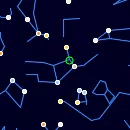NGC4809 Observation Details

NGC4809 Daily Motion
NGC4809 will be visible until July, 25, when it will move too close to the Sun. During this time, its proximity to the Sun will cause it to disappear from the night sky, making it unobservable for a while.
NGC4809 Visibility Timetable on December 22
NGC4809 Rise and Set Timetable
| Time | Elevation | |
| NGC4809 transit | 05:00 | 55° |
| Moon Rise, 2.6% illuminated | 06:55 | 46° |
| NGC4809 set | 11:08 | |
| Moon Set | 16:22 | -49° |
| Astrosession begin | 16:27 | -49° |
| NGC4809 rise | 22:49 | |
| Astrosession end | 03:45 | 52° |
| Civil sunrise | 04:49 | 55° |
| Sunrise | 05:20 | 55° |
Track NGC4809 Position Throughout the Night
← Mon, 22 December 2025 →
| Time | |
| Altitude | |
| Azimuth |
Shift the map to change the time and observe NGC4809 changing position in the night sky.
Where is NGC4809 right now?
NGC4809 is located in the constellation Virgo, at right ascension 12h 54m 51s" and declination 02° 39' 14s. At the current time, it is above the horizon at an altitude of 10 degrees toward the west from your location, with an apparent magnitude of 13.78.Finder Chart for NGC4809
Double-click to unlock the map.
| Object name | NGC4809 |
| Field of view | |
| Limiting magnitude | |
| NGC4809 coordinates | 12.91418, 2.65408 |
| Center coordinates | 12.91418, 2.65408 |
NGC4809 Passage Through Night
Double-click to unlock the map.
Current position of NGC4809
| Time | 23:38 |
| Latitude | 37.3541 |
| Longitude | -121.955 |
| NGC4809 elevation | 10° |
| NGC4809 Azimuth | -94° |
Here you can see the current position of the NGC4809 on the map, as well as its positions for rise and set. This tool allows you to track the NGC4809's movement throughout the night, providing you with accurate and up-to-date information.
Annual motion of NGC4809
| Date | Tue, 23 December 2025 |
| Twighlight start | 16:23 |
| Twighlight end | 03:39 |
| Twighlight duration | 11h 15m |
| Rise | 22:45 |
| Set | 11:00 |
| Elevation at transit | 55° |
| Transit time | 04:53 |
| Equatorial coordinates | RA: 12h 54m 51s", Dec: 02° 39' 14s |
| Magnitude | 14 |
| Constellation | Virgo |
The graph illustrates the annual visibility pattern of a NGC4809, providing a comprehensive overview of its daily appearances and transit times throughout the year.
The graph is structured with the vertical axis showing the hours of the day, ranging from 12 AM to 12 AM the next day, while the horizontal axis spans each day of the year.
The reddish shaded area indicates the periods when the NGC4809 is above the horizon, visible to observers. The white line marks the times when the celestial object reaches its highest point in the sky each day, known as the transit.
The graph is structured with the vertical axis showing the hours of the day, ranging from 12 AM to 12 AM the next day, while the horizontal axis spans each day of the year.
The reddish shaded area indicates the periods when the NGC4809 is above the horizon, visible to observers. The white line marks the times when the celestial object reaches its highest point in the sky each day, known as the transit.
Astrometric & Physical Parameters of NGC4809
Coordinates & Visibility
| Right Ascension | 12.91418° |
| Declination | 2.65408° |
| Magnitude | 13.78 |
| Constellation | Virgo |
| Elevation | 9.7° |
| Azimuth | -94.1° |
Data Credits
The nebulae information on this page is sourced from the OpenNGC project, developed by Matteo Verga. OpenNGC provides detailed data on the NGC catalog, which is a valuable resource for exploring deep-sky objects such as nebulae.
For more details or to contribute to OpenNGC, visit the official GitHub repository: OpenNGC on GitHub.
